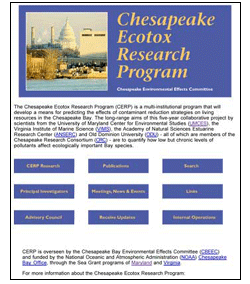![[Chesapeake Quarterly masthead]](/images/uploads/siteimages/imported/masthead.gif)
![[Chesapeake Quarterly masthead]](/images/uploads/siteimages/imported/masthead.gif) |
|
2003
|
Volume 2, Number 2
|
Table of Contents
|
Subscribe
|
Download pdf
|
ET CETERAReport, Research Assess Non-native Oyster
The National Academy of Science released in August its report on the risks and benefits of introducing the non-native oyster Crassostrea ariakensis to the Chesapeake Bay. The report largely echoed a number of white papers issued during the past year by Bay area scientists, calling for careful study and rigorous protocols. Maryland Sea Grant was one of about nine agencies that helped fund the study. Under the auspices of the National Research Council, the NAS panel of experts cautioned against the introduction of reproductive populations of C. ariakensis as a quick fix to the devastating losses of the Bay's native oyster, Crassostrea virginica, from entrenched parasitic diseases. Impetus for the study came from intense pressure in Virginia and Maryland for importing C. ariakensis to the Chesapeake because of its potential for surviving MSX and Dermo, the diseases that have so pummeled C. virginica. The NAS study examined three possible options: (1) no use of non-native oysters, (2) open water aquaculture of triploid [sterile] oysters, and (3) introduction of reproductive diploid oysters. Of the three options, the NAS committee considered the first risky because it might encourage rogue introductions by individuals, and the third "imprudent" since the introduction of a reproductive population would likely prove irreversible. Option two, they concluded, would present the least ecological uncertainty, while enabling researchers to learn more about C. ariakensis and its behavior in the Bay by experimenting with sterile triploid oysters. The report concludes, "If regulators enforce strict protocols for accountability . . . this management option could provide useful information to support decision analyses and risk assessments regarding the future use of non-native oysters in the Chesapeake Bay." Two research studies on Crassostrea ariakensis funded by NOAA Sea Grant are currently getting underway at the University of Maryland Center for Environmental Science. In one, under the Invasive Species Program, Roger Newell and Victor Kennedy are looking at potential predation on C. ariakensis. In the second, under the Oyster Disease Research Program, Ken Paynter and Don Meritt are comparing the growth and survival of sterile (triploid) C. ariakensis with that of sterile C. virginica in several rivers in Maryland's portion of the Bay. 
Understanding ContaminantsUnderstanding how chemical contaminants behave in the open environment, and how they affect living organisms, requires coordinated research by ecologists, toxicologists, population modelers and other experts. To foster such understanding, the Chesapeake Ecotoxicology Research Program (CERP) has brought together scientists with diverse scientific backgrounds from the University of Maryland Center for Environmental Science (UMCES), the Virginia Institute of Marine Science (VIMS), the Academy of Natural Sciences Estuarine Research Center (ANSERC) and the Old Dominion University (ODU). Scientists engaged in this collaborative five-year program are focusing on the Bay's toxic hot spots in the Anacostia River, Baltimore Harbor and Norfolk Harbor (the Elizabeth River). Their research centers on sub-lethal levels of contaminants, especially in Bay sediments, and the potential ways in which these pollutants could alter size-structure in estuarine populations and otherwise reduce the reproductive fitness of Bay organisms, slow their growth rate or alter their distribution or behavior. The CERP project is overseen by the Chesapeake Bay Environmental Effects Committee (CBEEC) and funded by the National Oceanic and Atmospheric Administration (NOAA) Chesapeake Bay Office, through the Sea Grant programs of Maryland and Virginia. For more on CERP, visit www.mdsg.umd.edu/CERP/ or contact Merrill Leffler at 301.403. 4220, ext. 20, or leffler@mdsg.umd.edu. Research Fellows SymposiumEight Maryland Sea Grant Research Fellows presented their research findings at a June symposium held at the UMCES Chesapeake Biological Laboratory in Solomons. The audience for the talks included faculty, staff and Research Experience for Undergraduate (REU) Fellows studying for the summer at marine labs on the Chesapeake Bay. The research fellowships, which provide a stipend, tuition remission and other benefits, are awarded through a competitive process to students working on Maryland Sea Grant-funded projects. Presentation highlights included a talk by Larry Taylor, a Ph.D. candidate, on his molecular biology research concerning a novel marine bacterium that can degrade various types of plants and shell material. This research has important implications for the global carbon cycle as well as the recycling of waste. Sarah Kolesar, also a Ph.D. candidate, presented her results about the interaction between ctenophores and fish larvae. This research will increase our understanding of jellyfish occurrence and persistence in the Chesapeake Bay. Olaf Jenson, an M.S. candidate, gave a presentation on the spatial distribution of blue crabs in the Chesapeake Bay. His approach, using a Geographical Information System to map blue crab occurrence and habitat, will provide new information that could help to improve blue crab fisheries management strategies. Other presenters were Jason Adolf, Patrick Campfield, Jessica Davis, Rebecca Holyoke and Laurie Bauer. Abstracts of the talks will be available on the Maryland Sea Grant web site and will also be published in a special symposium volume. |
|
|
Top of Page |
|
|
Home |
Contents |
Other Issues |
|
|
|
||||
![[Maryland Sea Grant]](/images/uploads/siteimages/imported/h_footer_mdsg.gif) ![[NOAA]](/images/uploads/siteimages/imported/h_footer_noaa.gif) |
This page was last modified November 19, 2003 |